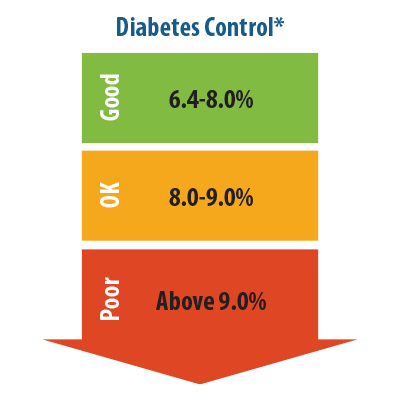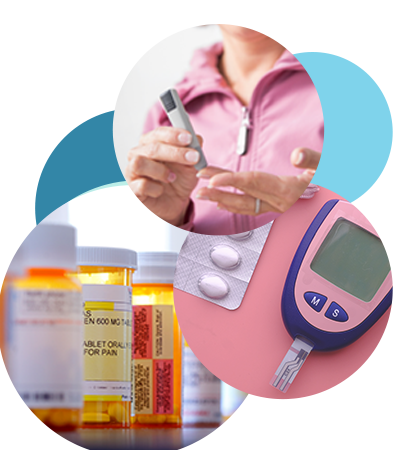Know Your Diabetes ABCs
A is for A1C test
A hemoglobin A1C test (or HBA1C ) is a blood test that measures your average blood sugar level over the past three months.
When sugar enters your bloodstream, it attaches to hemoglobin, a protein in your red blood cells. The A1C test measures the percentage of your red blood cells that have sugar-coated hemoglobin. Everyone has some sugar attached to their hemoglobin, but people with higher blood sugar levels have more. The test result is show as a percentage.

Work with your healthcare provider to set an A1C goal that is right for you. Your goal range may be different if you have other health conditions or if your blood sugar is often low or high.
The A1C test can help you manage your diabetes by showing:
- Whether a treatment plan is working
- How healthy choices make a difference in diabetes control
A1C in good control can lower your risk of heart disease, vision loss, kidney disease and other diabetes-related complications.
Your healthcare provider will check your A1C level every three months to see whether your treatment plan is working. Once your diabetes is well-controlled with your current treatment, your provider may only check your A1C twice a year or every six months. To learn more about the A1C test, visit the Centers for Disease Control (CDC) website.
The blood sugar checks you do every day are different from the A1C test
Depending on your medicines and your diabetes control, your provider may have you check your blood sugar at home. These blood sugar checks can be a helpful tool for managing your diabetes. They can tell you whether your blood sugar levels are low, high or within your goal range. You may benefit from checking blood sugar regularly if you take insulin, are pregnant, have a hard time reaching blood glucose targets or have had low blood glucose levels in the past.
- Work with your healthcare provider to set a blood sugar goal that is right for you
- Ask your healthcare provider if you should check your blood sugar at home
- Be sure to talk with your healthcare provider or pharmacist about how and when to use a glucometer if prescribed
To get more information and tips for checking your blood sugar levels, visit the Centers for Disease Control website.
B is for Blood Pressure
A blood pressure check measures the pressure in your arteries as your heart pumps. High blood pressure occurs when the pressure is higher than normal. Having diabetes increases your chances of having high blood pressure. Most people who have high blood pressure don’t have symptoms. The higher your blood pressure levels, the higher the risk for other health problems such as heart disease and stroke.
It is important to check your blood pressure at every visit with your healthcare provider. You can also check your blood pressure with a home blood pressure monitor or at a pharmacy that has a blood pressure machine.
If you don’t already have a blood pressure monitor, talk to your healthcare provider about the options available to you. They can order a blood pressure monitor from the pharmacy for pick up or send an order to one of HPSM’s in-network durable medical equipment (DME) providers who can mail you one.
CareAdvantage members: Get a blood pressure monitor at no cost through your Over-the-Counter (OTC) Benefit. Learn more.
Blood pressure chart
| Category | Systolic mm Hg | and/or | Diastolic mm Hg |
|---|---|---|---|
| Normal | Less than 120 | and | Less than 80 |
| Elevated (at-risk) | 120 – 139 | and | 80-89 |
| High Blood Pressure (Hypertension) Stage 2 | 140 or higher | or | 90 or higher |
- Work with your healthcare provider to set a blood pressure goal that is right for you. Your blood pressure should be under 140/90, unless they have told you differently.
- Ask your healthcare provider if you need to check your blood pressure at home.
To learn more about the importance of checking your blood pressure, visit the American Heart Association website.
C is for Cholesterol
Cholesterol is a type of fat-like substance in your blood. Fatty foods from animals, like meats and dairy products, also have cholesterol. If you have too much cholesterol in your blood, it can build up in your blood vessels. This raises your risk of heart disease, heart attack and stroke. Diabetes can cause problems in your body that may also lead to heart disease. This means that the risk of heart attack and stroke are higher for people with diabetes.
If you have high cholesterol, you will not have any symptoms. The only way to know whether you have high cholesterol is to get your cholesterol checked. The cholesterol test requires a blood draw. Be sure to ask your healthcare provider how to prepare for this test.
Make sure to also talk with your healthcare provider to see if you should take medicine for your cholesterol. Statins are medicines that can decrease cholesterol in your blood. They can also lower your risk of heart attack and stroke.
Talk with your healthcare provider about:
- What your cholesterol results mean
- Whether you should take a statin medicine
To learn more about cholesterol, visit the Centers for Disease Control (CDC) website.
